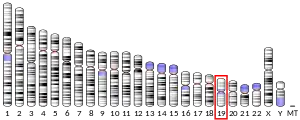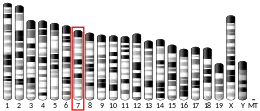ZNF444
Zinc finger protein 444 is a protein that in humans is encoded by the ZNF444 gene. [5]
| ZNF444 | |||||||||||||||||||||||||||||||||||||||||||||||||||
|---|---|---|---|---|---|---|---|---|---|---|---|---|---|---|---|---|---|---|---|---|---|---|---|---|---|---|---|---|---|---|---|---|---|---|---|---|---|---|---|---|---|---|---|---|---|---|---|---|---|---|---|
| Identifiers | |||||||||||||||||||||||||||||||||||||||||||||||||||
| Aliases | ZNF444, EZF-2, EZF2, ZSCAN17, zinc finger protein 444 | ||||||||||||||||||||||||||||||||||||||||||||||||||
| External IDs | OMIM: 607874 MGI: 1923365 HomoloGene: 10139 GeneCards: ZNF444 | ||||||||||||||||||||||||||||||||||||||||||||||||||
| |||||||||||||||||||||||||||||||||||||||||||||||||||
| |||||||||||||||||||||||||||||||||||||||||||||||||||
| |||||||||||||||||||||||||||||||||||||||||||||||||||
| |||||||||||||||||||||||||||||||||||||||||||||||||||
| |||||||||||||||||||||||||||||||||||||||||||||||||||
| Wikidata | |||||||||||||||||||||||||||||||||||||||||||||||||||
| |||||||||||||||||||||||||||||||||||||||||||||||||||
Function
This gene encodes a zinc finger protein which activates transcription of a scavenger receptor gene involved in the degradation of acetylated low-density lipoprotein (Ac-LDL) (Adachi H, Tsujimoto M (2002). "Characterization of the human gene encoding the scavenger receptor expressed by endothelial cell and its regulation by a novel transcription factor, endothelial zinc finger protein-2". J Biol Chem. 277 (27): 24014–21. doi:10.1074/jbc.M201854200. PMID 11978792.). This gene is located in a cluster of zinc finger genes on chromosome 19 at q13.4. A pseudogene of this gene is located on chromosome 15. Multiple transcript variants encoding different isoforms have been found for this gene.
References
- GRCh38: Ensembl release 89: ENSG00000167685 - Ensembl, May 2017
- GRCm38: Ensembl release 89: ENSMUSG00000044876 - Ensembl, May 2017
- "Human PubMed Reference:". National Center for Biotechnology Information, U.S. National Library of Medicine.
- "Mouse PubMed Reference:". National Center for Biotechnology Information, U.S. National Library of Medicine.
- "Entrez Gene: Zinc finger protein 444". Retrieved 2017-04-14.
Further reading
- Adachi H, Tsujimoto M (2002). "Characterization of the human gene encoding the scavenger receptor expressed by endothelial cell and its regulation by a novel transcription factor, endothelial zinc finger protein-2". J. Biol. Chem. 277 (27): 24014–21. doi:10.1074/jbc.M201854200. PMID 11978792.
This article incorporates text from the United States National Library of Medicine, which is in the public domain.



